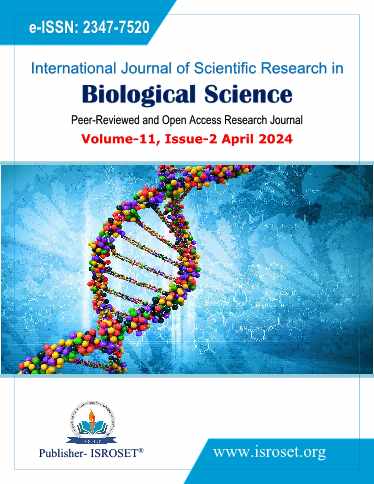Gut microbiota analysis of marsh crocodile (Crocodylus palustris) of Vishwamitri River
Keywords:
gut flora, microbiome, Firmicutes, Marsh crocodile, DNA isolationAbstract
A study was conducted to establish baseline information regarding the microbiome composition of the Marsh crocodile (Crocodylus palustris) gut flora through DNA isolation and sequencing of scat samples. Metagenomics, focusing on microbial communities within ecosystems, was employed to analyze the diverse microbiota, including bacteria, viruses, archaea, and eukaryotes. These microorganisms are ubiquitous and inhabit various environmental niches, such as soil, air, and water, and also form symbiotic relationships with host organisms, including their skin, lungs, and gastrointestinal tracts. Traditional bacterial biochemical identification approaches were found to be labor-intensive due to the inability to culture certain microbes. The use of One Codex software facilitated the analysis of the Marsh crocodile scat community, revealing a rich diversity comprising 84 phyla, 75 classes, 150 orders, 326 families, 1104 genera, and 3025 species. The gut microbiome is recognized for its significant impact on host health. In this study, Firmicutes predominated, comprising 50.07% of the phylum, followed by Proteobacteria, Actinobacteria, and Bacteroidetes. Notably, Firmicutes, including Bacilli, Gammaproteobacteria, and Clostridia, were associated with high levels of fecal coliforms in the aquatic environment inhabited by Marsh crocodiles.
References
A. Mobaraki, E. Abtin, H. G. Kami, and B. Kiabi, "Reproductive biology of the Mugger Crocodile, Crocodylus palustris, in Iran (Reptilia: Crocodylidae)," Zoology in the Middle East, vol. 59, 2013, doi: 10.1080/09397140.2013.841423.
A. Mobaraki, E. Abtin, H. G. Kami, and B. Kiabi, "Reproductive biology of the Mugger Crocodile, Crocodylus palustris, in Iran (Reptilia: Crocodylidae)," Zoology in the Middle East, vol. 59, pp. 1-10, 2013, doi: 10.1080/09397140.2013.841423.
C. Santiapillai and M. de Silva, "Status, distribution and conservation of crocodiles in Sri Lanka," Biological Conservation, vol. 97, no. 3, pp. 305-318, 2001.
R. Vyas, "Current status of Marsh Crocodiles Crocodylus palustris (Reptilia: Crocodylidae) in Vishwamitri River, Vadodara City, Gujarat, India," Journal of Threatened Taxa, vol. 4, no. 14, pp. 3333-3341, 2012.
R. Vyas, "Current status of Marsh Crocodiles Crocodylus palustris (Reptilia: Crocodylidae) in Vishwamitri River, Vadodara City, Gujarat, India," J. Threat. Taxa, vol. 4, no. 14, pp. 3333-3341, 2012.
R. C. Gupta, "Indian marsh mugger and its tunnel residency behavioural patterns in a sanctuary premises in Haryana, India," J. Appl. Nat. Sci., vol. 3, no. 1, pp. 25-28, 2011.
R. V. S. Pawaiya, A. K. Sharma, D. Swarup, and R. Somvanshi, "Pathology of mycotic gastritis in a wild Indian freshwater/marsh crocodile (Mugger; Crocodylus palustris): a case report," Vet. Med., vol. 56, pp. 135-139, 2011.
R. Vyas, "Current status of Marsh Crocodiles Crocodylus palustris (Reptilia: Crocodylidae) in Vishwamitri River, Vadodara City, Gujarat, India," J. Threat. Taxa, vol. 4, no. 14, pp. 3333-3341, 2012.
R. Vyas, "The Muggers (Crocodylus palustris) of Vishwamitri River: Past and Present," Herpetology and Environmental Research Project (HERP), Vadodara, Gujarat State, 32, 2010.
K. O. Chua, S. L. Song, H. S. Yong, W. S. See-Too, W. F. Yin, and K. G. Chan, "Microbial community composition reveals spatial variation and distinctive core microbiome of the weaver ant Oecophylla smaragdina in Malaysia," Sci. Rep., vol. 8, no. 1, p. 10777, 2018.
P. S. Clarke, "The natural history of sensitivity to jack jumper ants (Hymenoptera formicidae Myrmecia pilosula) in Tasmania," Med. J. Aust., vol. 145, no. 11-12, pp. 564-566, 1986.
G. A. Cresci and E. Bawden, "Gut microbiome: what we do and don`t know," Nutr. Clin. Pract., vol. 30, no. 6, pp. 734-746, 2015.
G. A. Cresci and E. Bawden, "Gut microbiome: what we do and don`t know," Nutr. Clin. Pract., vol. 30, no. 6, pp. 734-746, Nov.-Dec. 2015.
R. J. Dillon and V. M. Dillon, "The gut bacteria of insects: nonpathogenic interactions," Annu. Rev. Entomol., vol. 49, no. 1, pp. 71-92, 2004.
G. A. Cresci and E. Bawden, "Gut microbiome: what we do and don`t know," Nutr. Clin. Pract., vol. 30, no. 6, pp. 734-746, Nov.-Dec. 2015.
P. S. Clarke, "The natural history of sensitivity to jack jumper ants (Hymenoptera formicidae Myrmecia pilosula) in Tasmania," Med. J. Aust., vol. 145, no. 11-12, pp. 564-566, Nov.-Dec. 1986.
R. Siddiqui, S. Maciver, A. Elmoselhi, N. C. Soares, and N. A. Khan, "Longevity, cellular senescence and the gut microbiome: Lessons to be learned from crocodiles," Heliyon, vol. 7, no. 12, 2021.
Downloads
Published
How to Cite
Issue
Section
License

This work is licensed under a Creative Commons Attribution 4.0 International License.
Authors contributing to this journal agree to publish their articles under the Creative Commons Attribution 4.0 International License, allowing third parties to share their work (copy, distribute, transmit) and to adapt it, under the condition that the authors are given credit and that in the event of reuse or distribution, the terms of this license are made clear.







